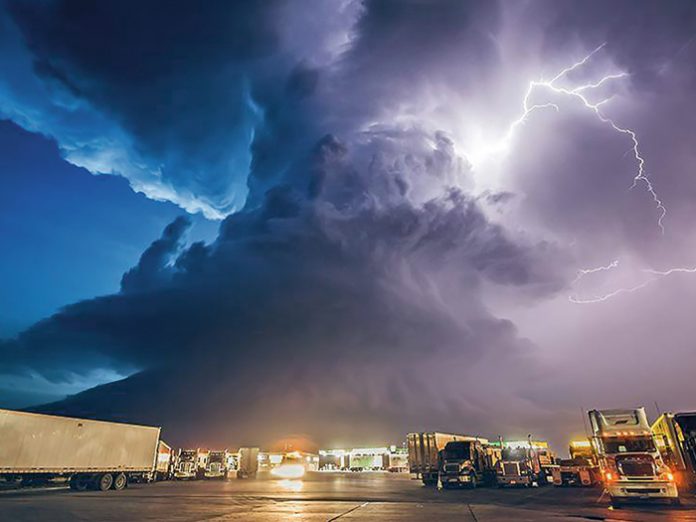This article was originally published in the spring issue of Protocol Magazine, and was written by Dr. Kevin Kloesel, who chairs the esteemed weather advisory group for the Event Safety Alliance.
Lightning kills thousands of people across the globe every year. Lightning also arrives with an audible alert system (thunder). Thunder is an immediate warning of dangerous conditions outside. If thunder is heard, anyone outside is in danger of being struck by lightning. It does not have to be raining for lightning to occur. In fact, many lightning fatalities occur when rain is not falling. Other threats, such as damaging winds, large hail, flash flooding, or even a tornado, also may be present. When lightning threatens, immediate action needs to occur to promote life safety. A good Lightning Safety Plan specifies the actions that will be taken.
The following is a quick, eight-point outline of items to be included in any Lightning Safety Plan. A good plan will include at least these elements. Your plan may include more elements, but it is important that every lightning plan include the specific people in the chain of command responsible for implementing and acting on the plan. Once you have your plan, follow it! Hoping that the storm misses your location is not a plan.
The following items are from guidance provided by the National Weather Service (NWS), the Event Safety Alliance, and the National Center for Spectator Sports Safety and Security. These organisations are at the forefront of protecting life and property, and serve as tremendous resources in developing any emergency plan.
ITEM 1: Set a minimum safe lightning radius appropriate to the current meteorological research regarding lightning behaviour.
The current standard of care in lightning protection is to use an 8 mile (13 km) radius as the safe zone. The 8-mile (13 km) standard has been implemented by dozens of sports and entertainment organisations, including the National Collegiate Athletics Association (See Guideline 1.E of the NCAA Sports Medicine Handbook 2014 – 2015), the National Center for Spectator Sports Safety and Security, and the Event Safety Alliance. The goal of every Lightning Safety Plan should be to complete the evacuation of your outdoor entertainment or event space before lightning reaches the 8-mile (13 km) radius.
ITEM 2: Be flexible enough to increase the minimum lightning radius against factors such as crowd size, crowd demographics / mobility, location and distance to available shelter, the speed of the storm, and so on.
Outdoor venues typically host events of varying size and complexity. In order to create a suitable safe lightning radius for an outdoor venue, crowd size and the speed of the expected storm must be taken into account. It is recommended that your Lightning Safety Plan involve a professional meteorologist to determine a safe radius for each venue. Lightning Safety Plans should adapt to take into account how long it takes to move a large crowd to shelter in the face of a swift-moving lightning storm. Although the 8-mile (13 km) radius is the minimum recommended, many outdoor venues in the US now use a 10-mile (16 km) radius to allow time to evacuate all patrons to safety, as well as secure the venue against potential damage.
ITEM 3: Identify vulnerable spaces where lightning poses a significant hazard to patrons, staff, or entertainers.
There is no safe place outside when lightning is in the area. If you hear thunder, you are likely within striking distance of lightning. Don’t worry about the flash-to-bang time or counting in an attempt to determine distance. Quickly implementing your Lightning Safety Plan is a better use of time. Two slogans stand out for outreach purposes. “When You See It, Flee It” and “When Thunder Roars, Go Indoors!”
Unsafe buildings include open garages, car ports, covered patios, picnic shelters, beach pavilions, golf shelters, tents of any kind, baseball dugouts, sheds, and partially enclosed vending areas. Unsafe vehicles include golf carts, construction equipment with open canopies, tractors, forklifts, bucket trucks or cherry pickers, convertibles, motorcycles, or any other open cab vehicle.
ITEM 4: Identify safe structures for lightning refuge (these could include autos, buses, etc.).
Your Lightning Safety Plan should identify substantial lightning-safe structures and have specific evacuation instructions and maps. A lightning-safe structure is either a substantial building (one with plumbing and wiring such as a home, school, church, office building, indoor concourse, or recreation center) or an enclosed metal vehicle. Once inside, stay away from showers, sinks, bathtubs, and electrical equipment such as radios connected to external antennas, corded telephones, and computers. A safe vehicle is any fully enclosed metal-topped vehicle such as a hard-topped car, minivan, bus, truck, etc. While inside a vehicle, do not open any windows and do not use electronic devices such as radios attached to external antennae or touch metal framing or fencing during a lightning storm.
ITEM 5: Designate a weather officer to monitor weather conditions, preferably in conjunction with a professional meteorologist.
The weather officer will be assigned the role of devoting attention to monitoring weather conditions. Before each event, the weather officer will review the weather forecast and monitor weather conditions. The weather officer’s primary responsibility is to notify command staff of any weather threats, and make sure the command staff has reviewed the Lightning Safety Plan. All command staff should be clearly identified in your plan. The weather officer should know how to access or make lightning forecasts, preferably with the assistance of a professional meteorologist. If available, mobile technology (through web pages or mobile applications) can be used to supplement weather information (radar, warnings) during the event. The weather officer’s main responsibilities are to keep eyes and ears to the sky, to be the liaison with a professional meteorologist or service, and to communicate any weather threats to the command staff and official in-charge.
ITEM 6: Craft pre-determined messages and communications protocols for notification of lightning risk, lightning threat, and lightning evacuation protocols (scripts, graphics, maps, etc.).
Event attendees need to be provided with the following information:
1. Before the event begins, inform attendees that a lightning threat exists and that protective action may be required that day. Provide instructions (maps, etc.) on what protective measures will be taken if the lightning threat materialises.
2. During the event, notify attendees of any imminent threat, and issue specific directions on taking protective action.
3. After any lightning delay, issue an ‘all clear’ notice when it is safe to leave the lightning-safe structure or return to the event location.
Consider handing out lightning safety brochures or information sheets at the beginning of a season and/or at the day of an event, and make heavy use of social media to announce the threat. Signs alone cannot satisfy the public notification recommendations, but they can supplement your plan. When lightning is forecast for the day of the event, the weather officer and command staff should use any or all means to communicate the possibility of threatening weather to the attendees, and the safety precautions that will take place if needed. Methods of dissemination may include pre-written or pre-recorded public address announcements, video board messages, venue TV monitors, social media, text alerts, and maps to shelters.
ITEM 7: Designate an official-in-charge decision maker with the responsibility for postponing / cancelling an event due to lightning.
A Lightning Safety Plan must include a Chain of Command. The Chain of Command should list all command staff personnel with decision-making authority to initiate lightning evacuation procedures. The command staff official-in-charge of the lightning decision will suspend the event and initiate protective measures for the staff and attendees upon recommendation from the weather officer or professional meteorologist or service. Complete evacuation from the event area should be considered if there are no lightning-safe structures available for everyone, or if the official-in-charge determines that a restart of the event will not be possible. Outdoor activity can resume after 30 minutes of lightning-free conditions within the 8-mile radius.
ITEM 8: Provide lightning safety and first aid training for all staff.
Educate the staff so they know the lightning safety rules and are comfortable with all aspects of the written Lightning Safety Plan. All staff should understand the Lightning Safety Plan before an event begins. Review the lightning procedures and rehearse if necessary. In addition, the following supplemental information may help alleviate misconceptions or misinformation regarding lightning and lightning safety:
• NWS Severe Thunderstorm Warnings are not issued based on lightning. All thunderstorms produce lightning and are potentially deadly. A Severe Thunderstorm Watch or a Tornado Watch is issued when conditions are favourable for the development of severe storms (wind gusts in excess of 58 mph, quarter-size hail or larger, or tornadoes). A Severe Thunderstorm Warning or Tornado Warning is issued when these specific weather criteria have been detected or may be imminent. There is no NWS warning for lightning.
• Most victims survive a lightning strike, however medical attention is needed immediately. Have someone call 911 (or whatever the emergency number is where you are). Victims do not carry an electrical charge and can be touched. In many cases, the victim’s heart or breathing may stop and rescue breathing or CPR may be needed. Monitor the victim until medical help arrives – heart and respiratory problems could persist, or the victim could go into shock. If possible, move the victim to a safer place away from the threat of another lightning strike. Work diligently to limit the exposure of first responders to additional lightning strikes.
• Lightning can strike outside of the rain area. In extreme cases, ‘bolts from the blue’ can strike 10 – 15 miles from the storm. Don’t wait for rain to begin to initiate the Lightning Safety Plan. Get to a safe structure, and don’t leave the safe structure just because the rain has let up.
• Many lightning casualties occur because people do not seek a safe structure soon enough. Many people wait far too long before reacting to this deadly weather threat, usually in the interest of trying to finish an activity / event. Don’t hesitate to stop the event and have patrons seek a lightning-safe structure if the sky appears threatening (especially if your weather officer or professional meteorologist knows lightning storms are a possibility). Lightning storms can develop directly overhead and some storms may develop lightning just as they arrive in your area. Make sure your venue personnel (ushers, etc.) know the Lightning Safety Plan and can model the safe behaviour that you seek from your patrons. Good leadership sets good examples and many patrons will follow clear and decisive actions from venue staff.
• Only about 10% of people who are struck by lightning are killed, leaving 90% with various degrees of disability, including life-long debilitating injuries.
Conclusion
These eight points are a brief outline of a Lightning Safety Plan. A complete, useful plan will have much more detail, which, of course, would be based on local knowledge of your venue and your patrons. The Event Safety Alliance is working to develop more detailed lightning safety guidance, but you can learn more about lightning and weather safety plans by attending the Severe Weather Summit held at the National Weather Center in Norman, OK, with subject matter experts from the venue industry, the University of Oklahoma, the private sector, and the NOAA National Weather Service. Severe weather safety planning also is sure to be a topic at a forthcoming Event Safety Summit in Lititz, PA. Visit the Event Safety Alliance’s website at https://eventsafetyalliance.org/ for updates.





